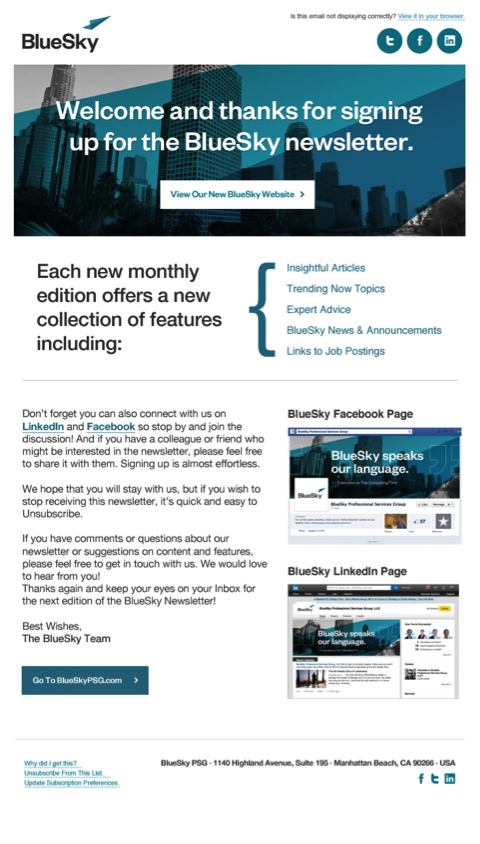CRM + Email: Your Equation for Boosting Revenue and Retaining Customers

It’s been said that customer insights are now the currency on which successful businesses are built. Mapping a product or service to a defined need in the market is no longer the end-point. Instead, savvy companies go beyond that by mining customer insights to dial-in the offering and make the customer’s decision to purchase as easy as possible.
While a tremendous amount of time and effort is spent attracting and converting customers, significantly less time is typically spent on retaining them. This is ironic considering that it costs on average 6 to 7 times more to attract a new customer than it does to retain an existing customer1. Smart companies no longer think of customers in terms of just sales. They think of their interactions with customers as a journey with each stage of that journey creating unique business opportunities.
CRM Basics
Customer Relationship Management (CRM) is a disciplined, focused approach to managing customer relationships through each stage of the customer journey. The ultimate goal of an effective CRM program is to maximize the lifetime value of each customer. And the way effective CRM programs achieve that goal is to:
- Create logical cross-sell, up-sell (or even re-sell) opportunities at relevant points in the customer journey
- And build an on-going relationship with customers that includes the post-sale or post-purchase stages of the customer journey.
The logic here is clear—delivering a consistent stream of value to customers at relevant points in their journey when they are most receptive can go a long way in building customer loyalty and boosting customer retention. All of these effects have a positive impact on your bottom line.
Successful CRM approaches cover all digital channels and seek to maximize the value of each of those touchpoints. For instance, your website is both a conversion tool for prospective customers as well as a repository of self-help resources for existing customers. Your social media channels can be leveraged to directly engage your customers in discussions, collect feedback and promote new products. Mobile can be incorporated to offer location-based promotions and deliver bite-sized product information optimized for customers on the go. But it’s the combination of CRM and email that can create some real magic for your customer relationships.
Incorporating Email
It’s easy to get bogged down in analysis (and that’s not really the point of this article) so we’ll cut to the chase. Relative to other marketing channels like social media, direct mail and paid search, email’s return on investment is typically 4 times greater. Given that fact, what’s the best way to incorporate email into your CRM program?
Define Your Customer Journey
If you haven’t already, define each stage of your customer journey. For many companies, this looks something like Awareness, Conversion, On-Boarding, Engagement, Loyalty, Retention and Win-Back. Create a set of customer communication objectives for each stage of the journey—what are the most important messages that prospective and/or current customers need to hear at each stage? What are the desired actions you want customers to take at each stage of the journey?
Create a Customer Communications Roadmap
Next, define a series of email touchpoints for each stage of your customer journey that you can use to support the customer communication objectives you outlined in the step above. Think about these touchpoints in two ways:
- Planned: Planned touchpoints follow a defined, pre-set cadence and are typically planned out in advance to support key marketing initiatives, events, product launches, etc.
- Triggered: These touchpoints are triggered by an event. For example, when a customer downloads a trial version of your software, an on-boarding email could be sent welcoming the customer and providing links to online resources that make his or her trial experience more valuable.
Focus Efforts on High Return Opportunities
Not all email opportunities are created equal. Know how to maximize opportunities at each stage and touchpoint. Some examples include:
- Welcome Emails: These emails that on-board new customers tend to have a higher open rate when compared to the other brand-sponsored email communications that typically follow. That makes a welcome email a particularly important opportunity to build trust by delivering immediate value.
Here’s an example of a welcome email we created for BlueSky Professional Services, our client in the Professional Search space. You’ll see how we used this opportunity to reinforce the value of the newsletter and also drive readers to further engage with the brand through social media.

- Post-Purchase Emails: Conventional wisdom holds that it takes three purchases to build consumer brand loyalty, so look for opportunities to create unique and valuable post-purchase email communications that are designed to motivate a second or third purchase.
We created this one specifically for those who purchased but were NOT newsletter subscribers. You legally have 90 days to communicate with a consumer post-purchase so we used this window to encourage newsletter sign-up. Once they subscribe we can continue to engage them and drive repeat purchase.

And here’s an example of how ThredUp used their brand personality to make this re-engagement email clever and fun.

- Make Me Smile Emails: Emails that celebrate a customer’s birthday or anniversary in a unique, creative way can be highly effective. Look for ways to deliver a personalized message and offer that reflects the customers purchasing patterns.
Nordstrom adds value beyond the inbox by inviting subscribers to special in-store events

Test, Measure & Optimize
Look for opportunities to test the effectiveness of your email touchpoints, messaging and design. Sometimes, significant performance boosts can be achieved with small changes to copy or creative. Simple A/B testing can be used to hone in on the subject lines, copy, design and offers that maximize open and response rates so test early and test often.
Create Your Own Customer Magic
We hope this quick and dirty how-to on integrating a CRM program with email marketing gave you some insights into how to get started. The team at 7th Floor Digital has created integrated CRM and email marketing programs for some of the world’s most recognized brands and we welcome the opportunity to discuss your needs, share what we’ve learned over the years and see how we can work together to put this powerful marketing combination to work for you.
1Source: ThinkJar

